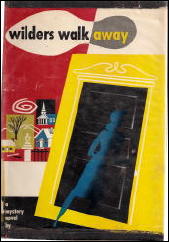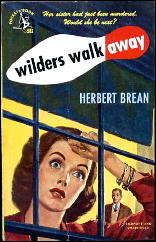Tue 27 Apr 2010
A 1001 MIDNIGHTS review: HERBERT BREAN – Wilders Walk Away.
Posted by Steve under 1001 Midnights , Reviews[2] Comments
by Bill Pronzini:
HERBERT BREAN – Wilders Walk Away. William Morrow & Co., hardcover, 1948. Hardcover reprint: Unicorn Mystery Book Club, 4-in-1 edition, June 1948. Reprint paperbacks include: Pocket #582, 1949; Collier, 1962; International Polygonics, 1988.

Free-lance magazine writer Reynold Frame comes to the Vermont village of Wilders Lane to do a series of articles on the colonial town and its history. The village’s founding family, the Wilders, are a decidedly curious bunch:
It is said that no Wilder ever died of old age; they just disappeared. In 1775 patriarch Jonathan Wilder walked down into the cellar of the family house and was never seen again. Another Wilder was a mate on the Mary Celeste. Still another vanished from a sandy beach in 1917, in full view of witnesses.
But Wilders “walking away” isn’t a phenomenon relegated to past history, as Frame soon learns. First young Ellen Wilder and then Aunt Mary also vanish from watched rooms inside the house, while he himself is on the premises.
There is plenty of eerie mystery here, a fine sense of small-town New England life circa 1948, and some fascinating bits and pieces of colonial history woven in. Plus a Revolutionary War treasure, secret passages and hidden rooms, an array of offbeat characters, and of course a love interest for Frame (Constance, one of the few Wilders who does not walk away).

The solutions to the “impossible” occurrences are well set up, if not particularly ingenious — the trickiest is the sandy-beach disappearance — but that doesn’t spoil the book’s appeal.
Reynold Frame appears in three other novels — The Darker the Night (1949), Hardly a Man Is Now Alive (1950), and The Clock Strikes Thirteen (1952) — all of which likewise make good use of unusual settings, strange doings, and past crimes.
Brean also created another journalist detective, William Deacon, for The Traces of Brillhart (1960) and The Traces of Merilee (1966).
———
Reprinted with permission from 1001 Midnights, edited by Bill Pronzini & Marcia Muller and published by The Battered Silicon Dispatch Box, 2007. Copyright © 1986, 2007 by the Pronzini-Muller Family Trust.
Editorial Comment: This title is one of those compiled in John Pugmire’s profusely illustrated article “A Locked Room Library,” to be found here on the main Mystery*File website. (Follow the link.)
April 27th, 2010 at 9:20 pm
Sounds interesting.
April 28th, 2010 at 1:33 pm
Brean, along with John Dickson Carr, Clayton Rawson, and Hake Talbot is one of the masters of the impossible crime. Though it isn’t really his best I did particularly enjoy THE CLOCK STRIKES THIRTEEN.